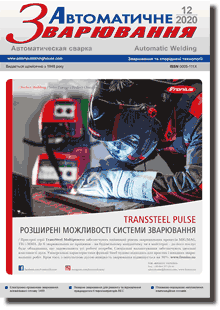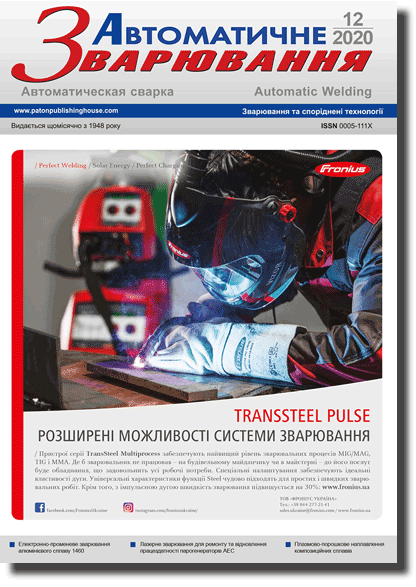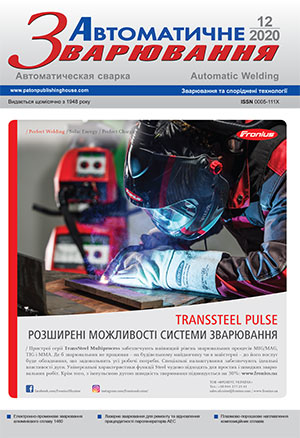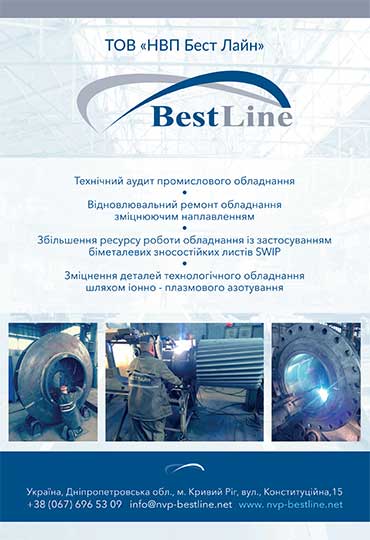| 2020 №12 (04) |
DOI of Article 10.37434/as2020.12.05 |
2020 №12 (06) |

"Avtomatychne Zvaryuvannya" (Automatic Welding), #12, 2020, pp. 37-43
Plasma-powder surfacing of composite alloys with separate feed of tungsten carbides and matrix alloy
A.I. Som, B.O. Halahuz
LLC firm «Plasma-Master Ltd». 52 Popudrenko Str, 02094, Kyiv. E-mail: info@plasma-master.com
Various combinations of separate feeding of cast spherical tungsten carbides and matrix alloy into the surfacing zone have been investigated. It has been established that when a self-fluxing nickel-based alloy is used as a matrix, the most stable surfacing process is achieved if tungsten carbides are fed through the axial hole of the focusing nozzle, and the matrix alloy through two channels located diametrically opposite to each other at its end. 6 Ref., 1 Tabl., 11 Fig.
Keywords: Plasma-powder surfacing, tungsten carbides, relite, self-fluxing alloy, matrix, carbide distribution, wear resistance, microhardness
Received: 2.12.2020
References
1. Harper, D., Gill, M., Hart, K W. D, Anderson, M. (2002) Plasma transferred arc overlays reduce operating costs in oil sand processing. In: Proc. of Int. Spray Conf. YTSC 2002 (Essen, Germany, May 2002), 278–283.2. Som, A.I. (2004) Plasma-powder surfacing of composite alloys based on cast tungsten carbides. The Paton Welding J., 10, 49–53.
3. Som, A.I. (1999) New plasmatrons for plasma-powder surfacing. Avtomatich. Svarka, 7, 44-48 [in Russian].
4. Zhudra, A.P. (2014) Tungsten carbide based cladding materials. The Paton Welding J., 6-7, 66-71. https://doi.org/10.15407/tpwj2014.06.13
5. Yuzvenko, Yu.A., Gavrish, V.A., Marienko, V.Yu. (1979) Laboratory units for evaluation of wear resistance of deposited metal. Theoretical and technological principles of surfacing. Properties and tests of deposited metal. Kiev, PWI, 23-27 [in Russian].
6. Gladky, P.V., Pereplyotchikov, E.F., Ryabtsev, I.A. (2007) Plasma surfacing. Kiev, Ekotekhnologiya [in Russian].
Advertising in this issue:
The cost of subscription/purchase order journals or individual articles
| Journal/Currency | Annual Set | 1 issue printed |
1 issue |
one article |
| TPWJ/USD | 384 $ | 32 $ | 26 $ | 13 $ |
| TPWJ/EUR | 348 € | 29 € | 24 € | 12 € |
| TPWJ/UAH | 7200 UAH | 600 UAH | 600 UAH | 280 UAH |
| AS/UAH | 1800 UAH | 300 UAH | 300 UAH | 150 UAH |
| AS/USD | 192 $ | 32 $ | 26 $ | 13 $ |
| AS/EUR | 180 € | 30 € | 25 € | 12 € |
| SEM/UAH | 1200 UAH | 300 UAH | 300 UAH | 150 UAH |
| SEM/USD | 128 $ | 32 $ | 26 $ | 13 $ |
| SEM/EUR | 120 € | 30 € | 25 € | 12 € |
| TDNK/UAH | 1200 UAH | 300 UAH | 300 UAH | 150 UAH |
| TDNK/USD | 128 $ | 32 $ | 26 $ | 13 $ |
| TDNK/EUR | 120 € | 30 € | 25 € | 15 € |
AS = «Automatic Welding» - 6 issues per year;
TPWJ = «PATON WELDING JOURNAL» - 12 issues per year;
SEM = «Electrometallurgy Today» - 4 issues per year;
TDNK = «Technical Diagnostics and Non-Destructive Testing» - 4 issues per year.









